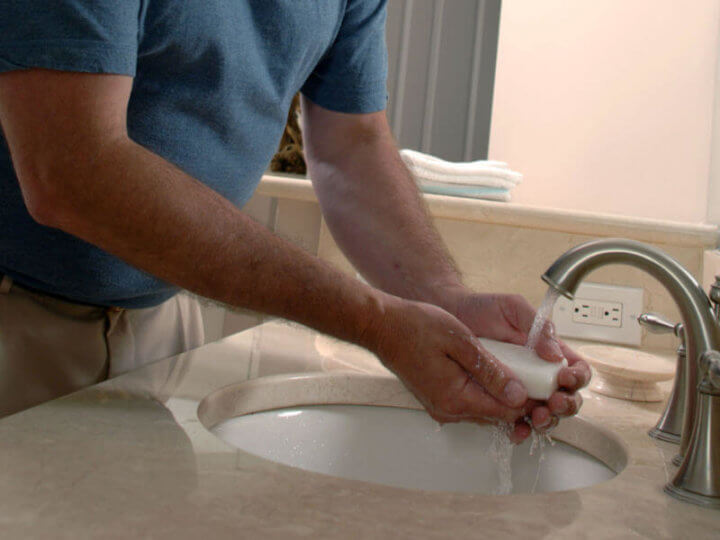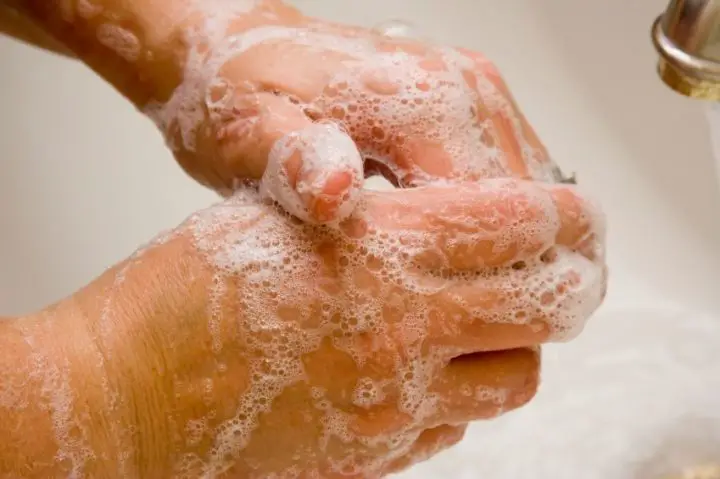
A clean face is essential to a good shave. But to wash your face you need to use clean hands. Washing hands have become a habit we formed from being taught by the people around us. Washing of hands may sound like a simple action but how you do it makes the story different. But, how do you really wash your hands properly?
Hand Washing Habit
American adults were surveyed in 2010 and were asked if they wash their hands after using a public bathroom: 96% said yes. This is according to a 2013 Michigan State Study published in the Journal of Environmental Health. But the bigger question is how many percent of this people wash their hands properly.
To find this out, the Michigan State Study asked a dozen of research assistants to post up in the bathrooms in Lansing and take up notes. They watched 3,700 bathroom goers and organized their results by gender, age, time of the day, bathroom cleanliness, hand dryer availability, time spent in washing and all other variables.
The findings showed that 10% of people did not wash their hands, 23% washed with water only and 67% with soap. However, washing with soap alone was not the goal of the study. The research further found out that 5% of people washed their hands with soap and water for 15 seconds or longer.
This method is what the Centers for Disease and Control and Prevention (CDC) recommends as the length of time in washing the hands as effective in removing high number of microbes in the hands.
Regular Soap Vs. Antibacterial Soap
In addition, the FDA also suggests to use a regular soap in washing hands rather than using the one with antibacterial ingredients. It is due to the fact that these soaps with antibacterial properties contain “triclosan” as the active ingredient. Triclosan is also common in clothing, kitchenware, toys and furniture so that they have antibacterial properties.
Triclosan has been in long debate with its effects to the human health. Animal studies have shown that triclosan can alter the normal functioning of hormones in the body. Because of that, people’s long-term exposure to triclosan is higher than previously thought, raising concerns about the potential risks associated with the use of this ingredient over a lifetime.
The Downside Of Antibacterial Soaps In Hand Washing
Aside from its ill effects due to the presence of triclosan, antibacterial soap might just not be very wise to use. Due to bacteria’s natural mechanism for faster adaptability, they are able to become resistant to anything that counteracts them. Their small size and big population enabled them to reproduce and die quickly. This fact invites bacteria to have faster mutation, thus faster resistance. This has long been a problem in medicine.
How to Properly Wash Your Hands
They say that keeping your hands clean is one of the ways to avoid getting sick and spreading the germs from others. Many infectious diseases are spread because of using dirty hands or not washing hands with clean, running water and soap. CDC suggests a specific way to avoid infections and spreading of germs to others. This recommendation was developed based on data from a number of studies that show effective handwashing technique.

Steps on Washing Your Hands Correctly- With Explanation to Understand Why It is Necessary
1.Wash your hands with the clean running water. Turn off the faucet then apply soap.
Using running water is better, hygienic and necessary. If you use a basin of standing water which has been used previously, it might be already contaminated. So washing with a contaminated water mean your hands may not clean to begin with. That is why a clean running water must be used instead.
The water temperature does not significantly affect the removal of germs. But, a warmer water may irritate your skin and is not environment-friendly.
2. Turn off the faucet after wetting the hands.
Using soap in washing the hands is more effective in removing dirt, grease and microbe than using water alone. The properties in the soap called surfactant allows the cleaning and removal of the grime. People also instinctively rub their hands with some soap which further removes the germs than with water alone.
Studies have also showed that using soaps with antibacterial ingredients is no better than using a regular soap. FDA proposed a rule in December 2013 to mandate manufacturers to submit a data supporting the efficacy and safety of antibacterial soaps and body washes. This proposed rule does not affect any antibacterial products used in healthcare settings such as wipes, hand sanitizers and others.
3. Foam your hands with the soap then rub them together.
Ensure to include the back of your hands, between your fingers and under your nails. Foaming and scrubbing your hands builds up friction which makes the dirt, grime and microbe removed faster. Microbes are all over the surface of your hand, so the entire hand should be scrubbed. Most importantly, make sure to clean your nails properly. It is where most microbe hide the best.
4. When scrubbing your hands, allot at least 20 seconds. Another alternative is to hum the song “Happy Birthday” twice from beginning to end.
Knowing the optimal length of time for handwashing is hard because there are not many studies that prove the health impacts of altering handwashing times. Among shown results, most of them have measured reductions in overall number of microbes. Just a small portion of which are disease-causing and have no measured impact on health. Dropping the number of microbes on the hand does not directly link to better health.
The optimal length of time for handwashing can be linked to few variables. Nonetheless, evidence shows that a 15-30-second hand washing may be effective in removing germs compared to shorter than this mentioned value.
Many countries around the world have adopted this recommended length of time in hand washing. Some also recommend an additional 20-30 seconds for drying.
5. Rinse hands well under the clean running water.
Soap and friction helped remove anything unclean on your hands including disease causing germs. To completely remove them, a clean running water help rinse them off. Rinsing the soap with water also lessens the skin irritation.
Again, if you use a basin of standing water, your hands may be contaminated again especially if the basin was used previously. This is why, you should use a clean running water.
In turning off the faucet, some recommend using a paper towel but it only increased use of water and paper towels. There were also no studies that show this method improves health.
6. Dry your hands with a clean towel or air dry them.
Even after washing hands, germs can be easily harbored by wet hands. This is why hands should be dried after washing. So far there are no clear and proven studies which is the best method in drying the hands after washing because result seem to antagonize each other.
In addition, most of these studies compare overall concentration of microbes, not just disease-causing germs, on hands after hand-drying methods. Results showed no significant health effects. Using a paper towel may also not recommended because of the waste and increased use of paper towel which is not environment-friendly. But studies suggest that utilizing a clean towel or simply air-drying the hands are the best.
Conclusion
Washing of hands is a good practice that we learned and are taught to do. Yet, most people don’t realize the proper way and the significant difference it gives to actually do it. When doing it properly and correctly means how you scrub the parts of your hands and how long it takes to kill the germs on your hands.
When talking about the significant difference, it means how much dirt and microbes present in your hands are removed to reduce chance of entering our body through body openings. Regular hand washing, particularly before and after certain activities, is one of the best ways to remove germs, avoid getting sick and prevent spreading germs to others. Handwashing is a good habit that is a win for everyone, except for germs.
About the Author:
 Jennifer Moran is the author and the social media manager at theberkey.com. She has been working and passionate with writing for over four years. When she isn’t glued to a laptop screen, she spends time playing tennis, practicing yoga, and trying very hard not to sleep in the meditation. You can reach her at jennifer (at) the berkey (dot) com.
Jennifer Moran is the author and the social media manager at theberkey.com. She has been working and passionate with writing for over four years. When she isn’t glued to a laptop screen, she spends time playing tennis, practicing yoga, and trying very hard not to sleep in the meditation. You can reach her at jennifer (at) the berkey (dot) com.
